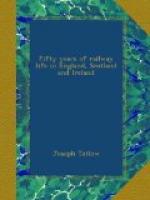New Zealand, Canada, South Africa and Newfoundland are each the happy possessor of one gauge only. In Canada it is the British gauge of 4ft. 8.5in., and in New Zealand, South Africa and Newfoundland, 3ft. 6in.
Our Final Report was signed on the 21st of February, 1917, and published as a Blue Book in the usual way, but, what is rarely done with any Blue Book, it was also published in handy book-form, bound in cloth, at the popular price of 1s. 6d. Blue Books do sometimes contain matter of general interest, are sometimes well written and readable, and would be more read if presented to the public in a handy form such as we succeeded in publishing.
The main purposes of the Commission I have already briefly stated. They embraced many subjects for inquiry and study, of which the following are the most important, and regarding each of which it may be appropriate to say a word or two:—
External Trade of the Self-Governing Dominions
We ascertained and compiled in detail, tables of the Imports and Exports, distinguishing Trade with (a) the United Kingdom, (b) the other parts of the Empire, and (c) with foreign countries. The figures showed the need there was for an Imperial trade policy, which should lead to British manufacturers and merchants cultivating more the Dominion markets, and utilising more the vast resources of raw materials which the Dominions possess. We found that a detailed examination of existing conditions, and practical and definite proposals for the removal of difficulties, were required.
Natural Resources of the Dominions
In regard to agricultural matters we gathered and published much information, finding that in one part or other of the Dominions all animals and almost every crop flourished that are needed by man, that if the products of the more tropical parts of the Empire were taken into account, the Empire could meet more than its own needs; and that if men existed in sufficient numbers in our Dominions, there was scarcely any limit to the external trade they could do. In this part of our Inquiry we found to what a considerable extent people concentrated in large cities to the detriment of the country districts. “Back to the land” is a question there of as much if not greater moment than in the Mother Country. The mineral resources of the Dominions, like the agricultural, provided us with a big subject. In every Province or State, by oral evidence, by official statistics, by discussion with Government geologists, officials of the Mines Departments and others, we gathered a large amount of valuable information. The volumes of printed evidence give full particulars of this and other subjects. The mineral deposits of Canada especially are varied in character and large in respect both of quantity and value—gold, silver, copper, lead, zinc, nickel, coal, iron, asbestos, natural gas, petroleum, peat, gypsum—all are found in unstinted quantity. Nor are the other Dominions deficient. The goldfields of Australia are historic, and the silver, lead and zinc mines of Broken Hill deserve particular mention. In South Africa gold and diamonds are plentiful; and Newfoundland has wonderful deposits of iron ore.




